Journal of International Business Studies doc
VerifiedAdded on 2022/08/26
|8
|1902
|18
AI Summary
Contribute Materials
Your contribution can guide someone’s learning journey. Share your
documents today.
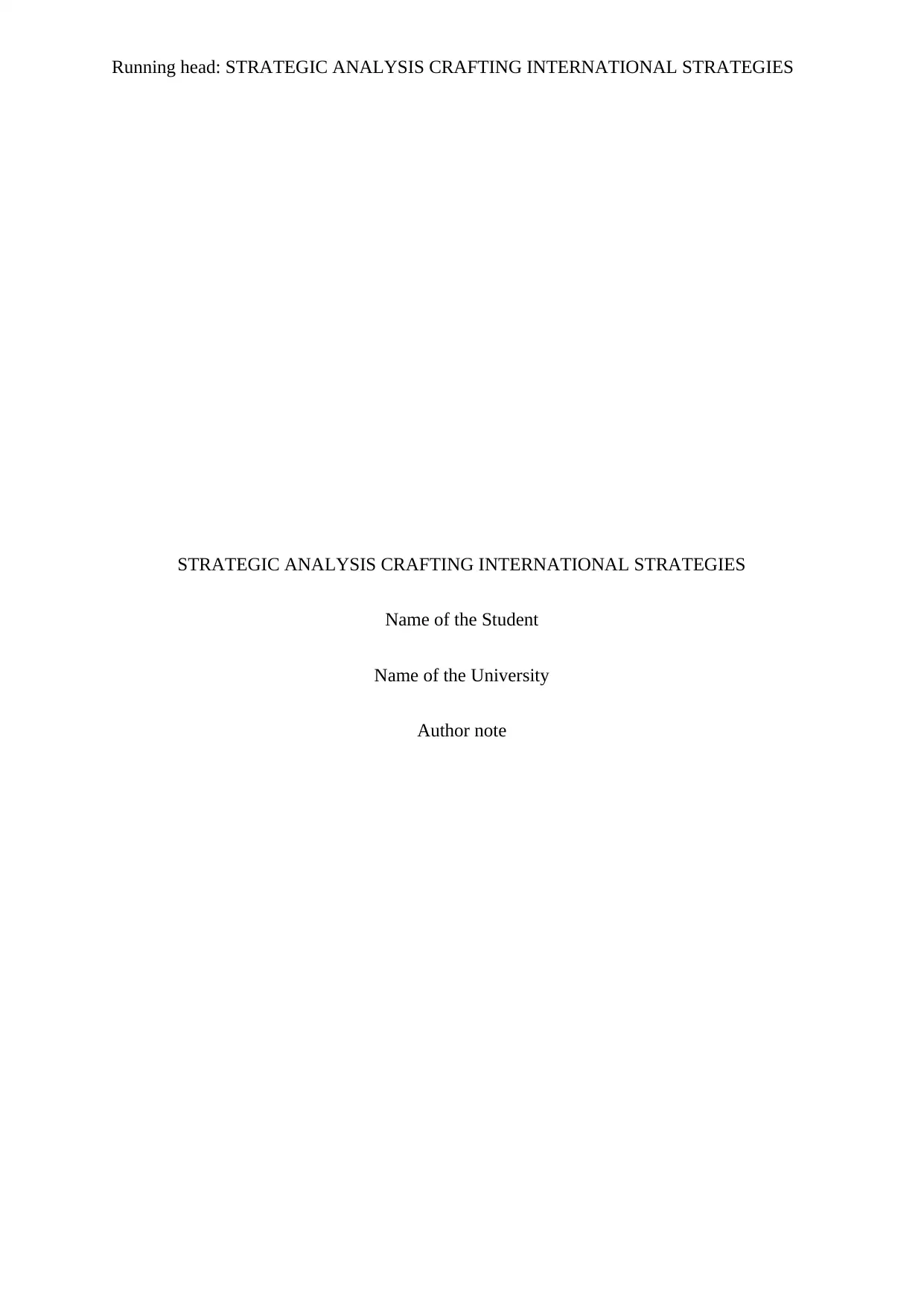
Running head: STRATEGIC ANALYSIS CRAFTING INTERNATIONAL STRATEGIES
STRATEGIC ANALYSIS CRAFTING INTERNATIONAL STRATEGIES
Name of the Student
Name of the University
Author note
STRATEGIC ANALYSIS CRAFTING INTERNATIONAL STRATEGIES
Name of the Student
Name of the University
Author note
Secure Best Marks with AI Grader
Need help grading? Try our AI Grader for instant feedback on your assignments.
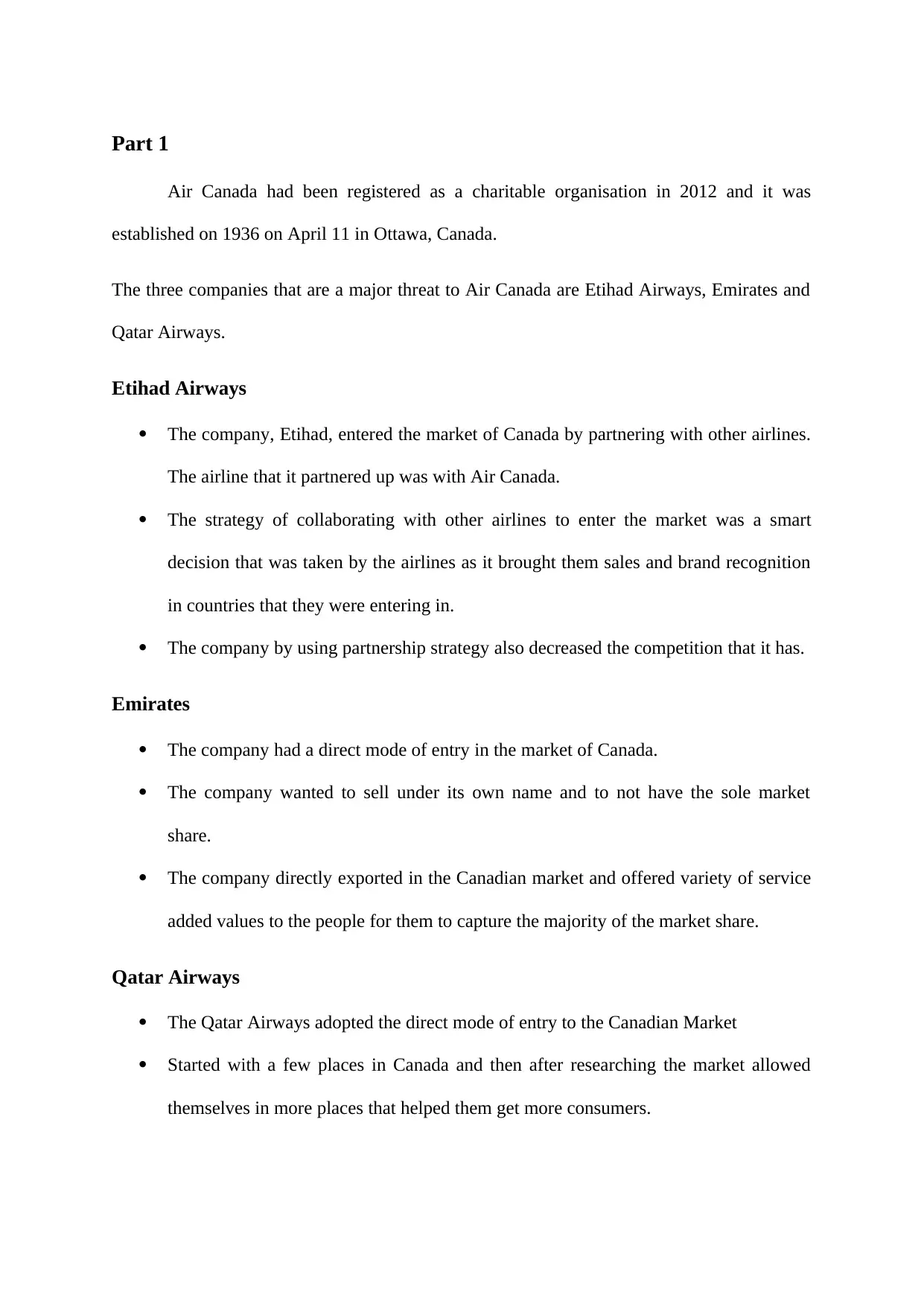
Part 1
Air Canada had been registered as a charitable organisation in 2012 and it was
established on 1936 on April 11 in Ottawa, Canada.
The three companies that are a major threat to Air Canada are Etihad Airways, Emirates and
Qatar Airways.
Etihad Airways
The company, Etihad, entered the market of Canada by partnering with other airlines.
The airline that it partnered up was with Air Canada.
The strategy of collaborating with other airlines to enter the market was a smart
decision that was taken by the airlines as it brought them sales and brand recognition
in countries that they were entering in.
The company by using partnership strategy also decreased the competition that it has.
Emirates
The company had a direct mode of entry in the market of Canada.
The company wanted to sell under its own name and to not have the sole market
share.
The company directly exported in the Canadian market and offered variety of service
added values to the people for them to capture the majority of the market share.
Qatar Airways
The Qatar Airways adopted the direct mode of entry to the Canadian Market
Started with a few places in Canada and then after researching the market allowed
themselves in more places that helped them get more consumers.
Air Canada had been registered as a charitable organisation in 2012 and it was
established on 1936 on April 11 in Ottawa, Canada.
The three companies that are a major threat to Air Canada are Etihad Airways, Emirates and
Qatar Airways.
Etihad Airways
The company, Etihad, entered the market of Canada by partnering with other airlines.
The airline that it partnered up was with Air Canada.
The strategy of collaborating with other airlines to enter the market was a smart
decision that was taken by the airlines as it brought them sales and brand recognition
in countries that they were entering in.
The company by using partnership strategy also decreased the competition that it has.
Emirates
The company had a direct mode of entry in the market of Canada.
The company wanted to sell under its own name and to not have the sole market
share.
The company directly exported in the Canadian market and offered variety of service
added values to the people for them to capture the majority of the market share.
Qatar Airways
The Qatar Airways adopted the direct mode of entry to the Canadian Market
Started with a few places in Canada and then after researching the market allowed
themselves in more places that helped them get more consumers.
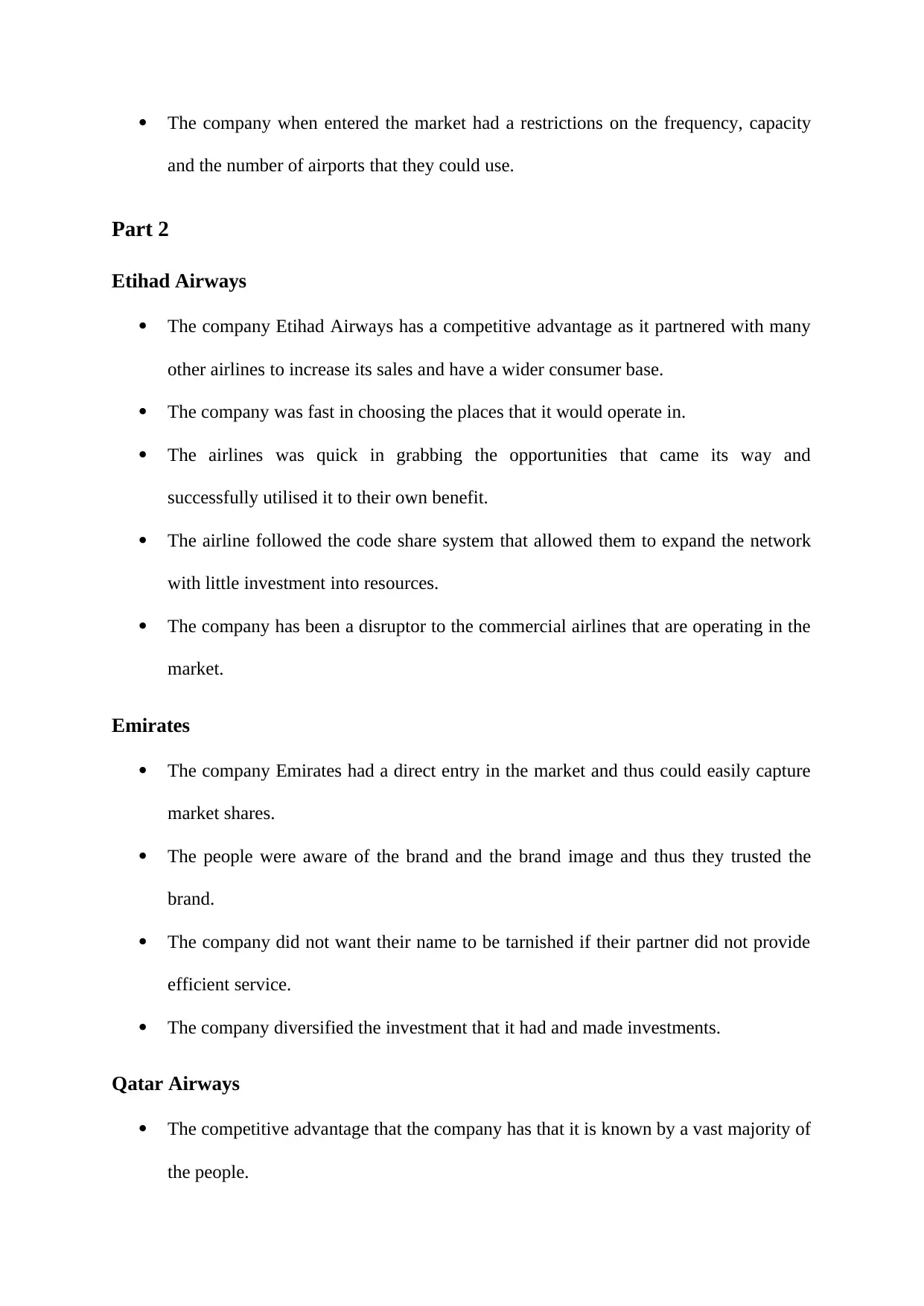
The company when entered the market had a restrictions on the frequency, capacity
and the number of airports that they could use.
Part 2
Etihad Airways
The company Etihad Airways has a competitive advantage as it partnered with many
other airlines to increase its sales and have a wider consumer base.
The company was fast in choosing the places that it would operate in.
The airlines was quick in grabbing the opportunities that came its way and
successfully utilised it to their own benefit.
The airline followed the code share system that allowed them to expand the network
with little investment into resources.
The company has been a disruptor to the commercial airlines that are operating in the
market.
Emirates
The company Emirates had a direct entry in the market and thus could easily capture
market shares.
The people were aware of the brand and the brand image and thus they trusted the
brand.
The company did not want their name to be tarnished if their partner did not provide
efficient service.
The company diversified the investment that it had and made investments.
Qatar Airways
The competitive advantage that the company has that it is known by a vast majority of
the people.
and the number of airports that they could use.
Part 2
Etihad Airways
The company Etihad Airways has a competitive advantage as it partnered with many
other airlines to increase its sales and have a wider consumer base.
The company was fast in choosing the places that it would operate in.
The airlines was quick in grabbing the opportunities that came its way and
successfully utilised it to their own benefit.
The airline followed the code share system that allowed them to expand the network
with little investment into resources.
The company has been a disruptor to the commercial airlines that are operating in the
market.
Emirates
The company Emirates had a direct entry in the market and thus could easily capture
market shares.
The people were aware of the brand and the brand image and thus they trusted the
brand.
The company did not want their name to be tarnished if their partner did not provide
efficient service.
The company diversified the investment that it had and made investments.
Qatar Airways
The competitive advantage that the company has that it is known by a vast majority of
the people.
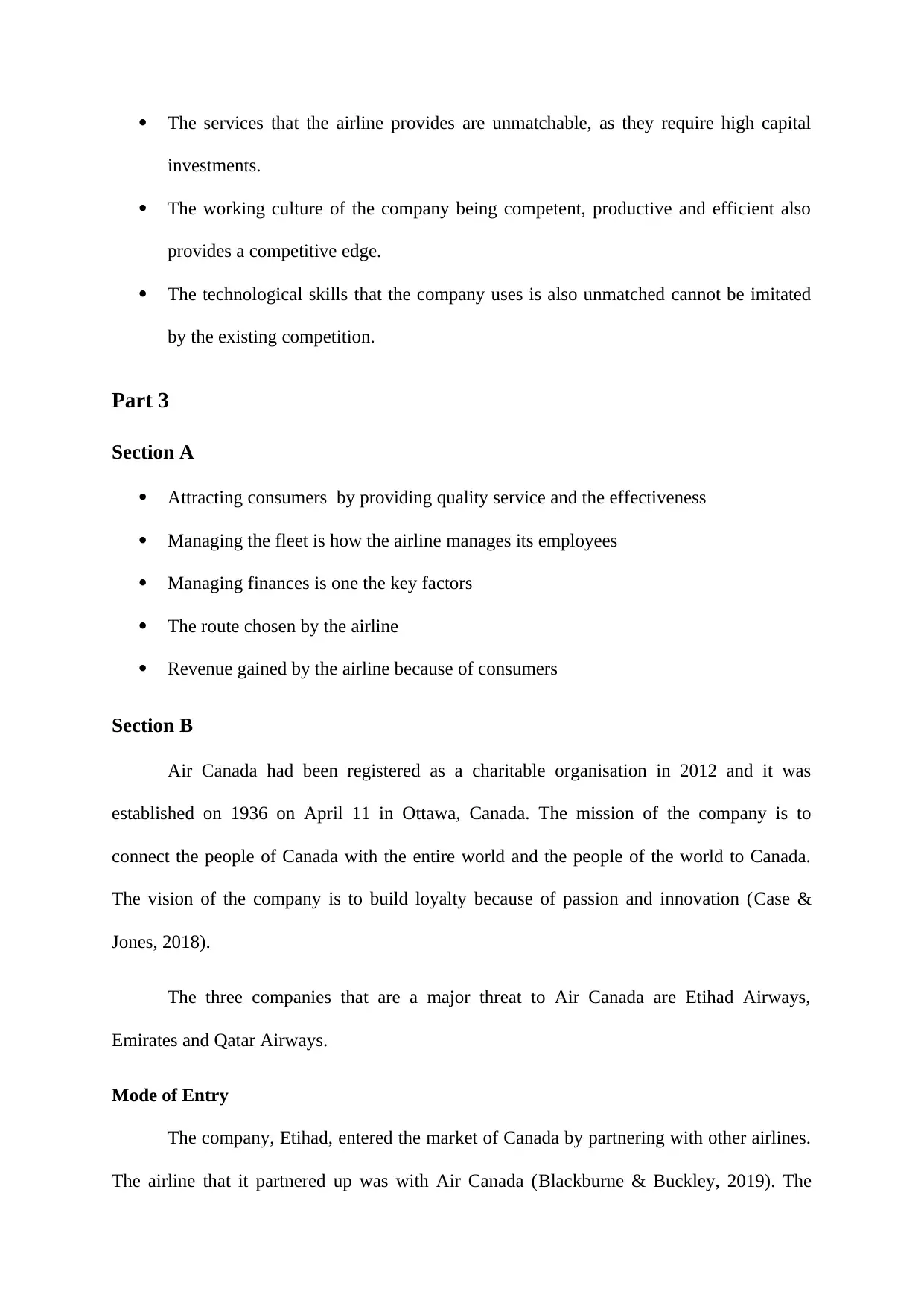
The services that the airline provides are unmatchable, as they require high capital
investments.
The working culture of the company being competent, productive and efficient also
provides a competitive edge.
The technological skills that the company uses is also unmatched cannot be imitated
by the existing competition.
Part 3
Section A
Attracting consumers by providing quality service and the effectiveness
Managing the fleet is how the airline manages its employees
Managing finances is one the key factors
The route chosen by the airline
Revenue gained by the airline because of consumers
Section B
Air Canada had been registered as a charitable organisation in 2012 and it was
established on 1936 on April 11 in Ottawa, Canada. The mission of the company is to
connect the people of Canada with the entire world and the people of the world to Canada.
The vision of the company is to build loyalty because of passion and innovation (Case &
Jones, 2018).
The three companies that are a major threat to Air Canada are Etihad Airways,
Emirates and Qatar Airways.
Mode of Entry
The company, Etihad, entered the market of Canada by partnering with other airlines.
The airline that it partnered up was with Air Canada (Blackburne & Buckley, 2019). The
investments.
The working culture of the company being competent, productive and efficient also
provides a competitive edge.
The technological skills that the company uses is also unmatched cannot be imitated
by the existing competition.
Part 3
Section A
Attracting consumers by providing quality service and the effectiveness
Managing the fleet is how the airline manages its employees
Managing finances is one the key factors
The route chosen by the airline
Revenue gained by the airline because of consumers
Section B
Air Canada had been registered as a charitable organisation in 2012 and it was
established on 1936 on April 11 in Ottawa, Canada. The mission of the company is to
connect the people of Canada with the entire world and the people of the world to Canada.
The vision of the company is to build loyalty because of passion and innovation (Case &
Jones, 2018).
The three companies that are a major threat to Air Canada are Etihad Airways,
Emirates and Qatar Airways.
Mode of Entry
The company, Etihad, entered the market of Canada by partnering with other airlines.
The airline that it partnered up was with Air Canada (Blackburne & Buckley, 2019). The
Secure Best Marks with AI Grader
Need help grading? Try our AI Grader for instant feedback on your assignments.
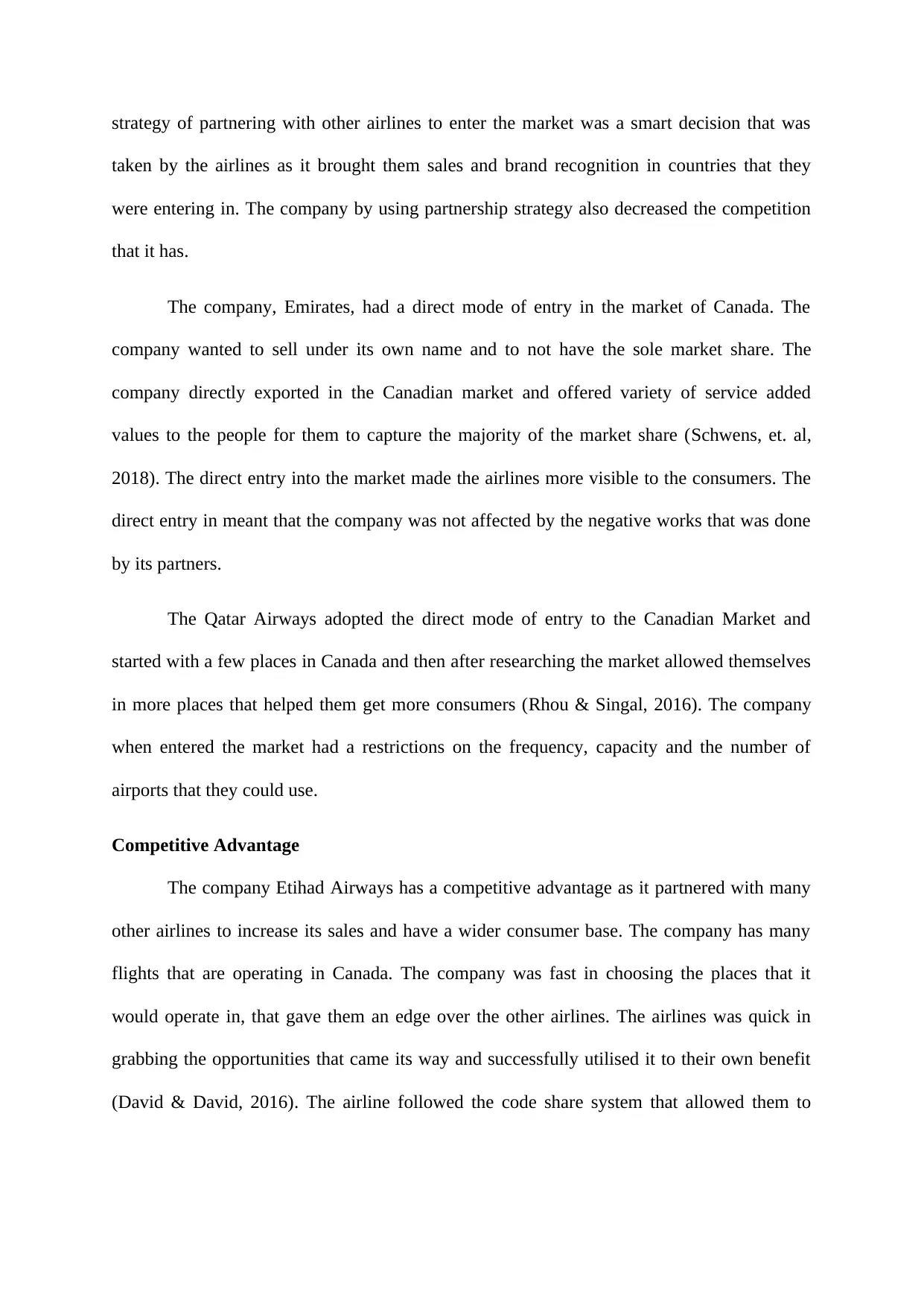
strategy of partnering with other airlines to enter the market was a smart decision that was
taken by the airlines as it brought them sales and brand recognition in countries that they
were entering in. The company by using partnership strategy also decreased the competition
that it has.
The company, Emirates, had a direct mode of entry in the market of Canada. The
company wanted to sell under its own name and to not have the sole market share. The
company directly exported in the Canadian market and offered variety of service added
values to the people for them to capture the majority of the market share (Schwens, et. al,
2018). The direct entry into the market made the airlines more visible to the consumers. The
direct entry in meant that the company was not affected by the negative works that was done
by its partners.
The Qatar Airways adopted the direct mode of entry to the Canadian Market and
started with a few places in Canada and then after researching the market allowed themselves
in more places that helped them get more consumers (Rhou & Singal, 2016). The company
when entered the market had a restrictions on the frequency, capacity and the number of
airports that they could use.
Competitive Advantage
The company Etihad Airways has a competitive advantage as it partnered with many
other airlines to increase its sales and have a wider consumer base. The company has many
flights that are operating in Canada. The company was fast in choosing the places that it
would operate in, that gave them an edge over the other airlines. The airlines was quick in
grabbing the opportunities that came its way and successfully utilised it to their own benefit
(David & David, 2016). The airline followed the code share system that allowed them to
taken by the airlines as it brought them sales and brand recognition in countries that they
were entering in. The company by using partnership strategy also decreased the competition
that it has.
The company, Emirates, had a direct mode of entry in the market of Canada. The
company wanted to sell under its own name and to not have the sole market share. The
company directly exported in the Canadian market and offered variety of service added
values to the people for them to capture the majority of the market share (Schwens, et. al,
2018). The direct entry into the market made the airlines more visible to the consumers. The
direct entry in meant that the company was not affected by the negative works that was done
by its partners.
The Qatar Airways adopted the direct mode of entry to the Canadian Market and
started with a few places in Canada and then after researching the market allowed themselves
in more places that helped them get more consumers (Rhou & Singal, 2016). The company
when entered the market had a restrictions on the frequency, capacity and the number of
airports that they could use.
Competitive Advantage
The company Etihad Airways has a competitive advantage as it partnered with many
other airlines to increase its sales and have a wider consumer base. The company has many
flights that are operating in Canada. The company was fast in choosing the places that it
would operate in, that gave them an edge over the other airlines. The airlines was quick in
grabbing the opportunities that came its way and successfully utilised it to their own benefit
(David & David, 2016). The airline followed the code share system that allowed them to
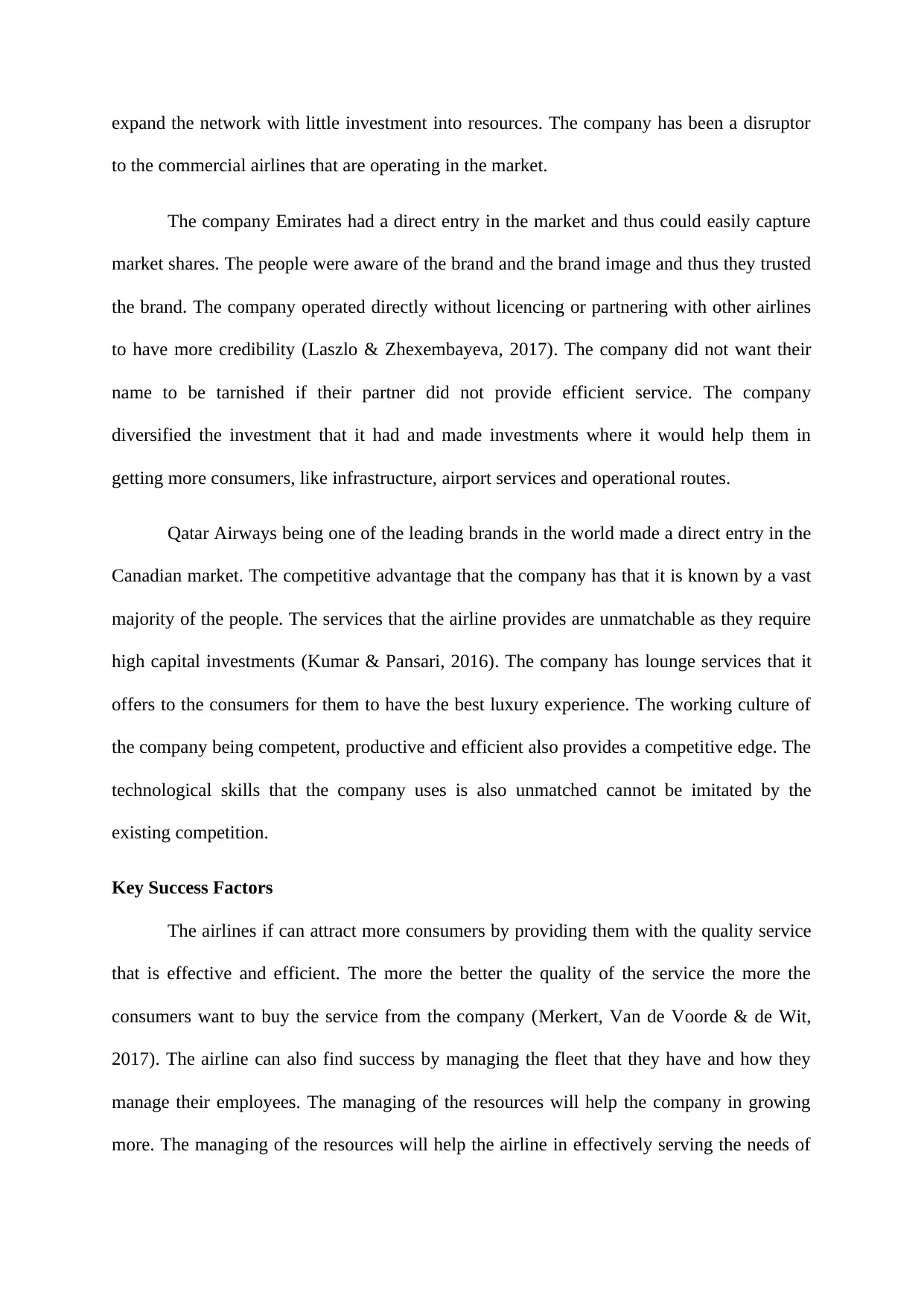
expand the network with little investment into resources. The company has been a disruptor
to the commercial airlines that are operating in the market.
The company Emirates had a direct entry in the market and thus could easily capture
market shares. The people were aware of the brand and the brand image and thus they trusted
the brand. The company operated directly without licencing or partnering with other airlines
to have more credibility (Laszlo & Zhexembayeva, 2017). The company did not want their
name to be tarnished if their partner did not provide efficient service. The company
diversified the investment that it had and made investments where it would help them in
getting more consumers, like infrastructure, airport services and operational routes.
Qatar Airways being one of the leading brands in the world made a direct entry in the
Canadian market. The competitive advantage that the company has that it is known by a vast
majority of the people. The services that the airline provides are unmatchable as they require
high capital investments (Kumar & Pansari, 2016). The company has lounge services that it
offers to the consumers for them to have the best luxury experience. The working culture of
the company being competent, productive and efficient also provides a competitive edge. The
technological skills that the company uses is also unmatched cannot be imitated by the
existing competition.
Key Success Factors
The airlines if can attract more consumers by providing them with the quality service
that is effective and efficient. The more the better the quality of the service the more the
consumers want to buy the service from the company (Merkert, Van de Voorde & de Wit,
2017). The airline can also find success by managing the fleet that they have and how they
manage their employees. The managing of the resources will help the company in growing
more. The managing of the resources will help the airline in effectively serving the needs of
to the commercial airlines that are operating in the market.
The company Emirates had a direct entry in the market and thus could easily capture
market shares. The people were aware of the brand and the brand image and thus they trusted
the brand. The company operated directly without licencing or partnering with other airlines
to have more credibility (Laszlo & Zhexembayeva, 2017). The company did not want their
name to be tarnished if their partner did not provide efficient service. The company
diversified the investment that it had and made investments where it would help them in
getting more consumers, like infrastructure, airport services and operational routes.
Qatar Airways being one of the leading brands in the world made a direct entry in the
Canadian market. The competitive advantage that the company has that it is known by a vast
majority of the people. The services that the airline provides are unmatchable as they require
high capital investments (Kumar & Pansari, 2016). The company has lounge services that it
offers to the consumers for them to have the best luxury experience. The working culture of
the company being competent, productive and efficient also provides a competitive edge. The
technological skills that the company uses is also unmatched cannot be imitated by the
existing competition.
Key Success Factors
The airlines if can attract more consumers by providing them with the quality service
that is effective and efficient. The more the better the quality of the service the more the
consumers want to buy the service from the company (Merkert, Van de Voorde & de Wit,
2017). The airline can also find success by managing the fleet that they have and how they
manage their employees. The managing of the resources will help the company in growing
more. The managing of the resources will help the airline in effectively serving the needs of
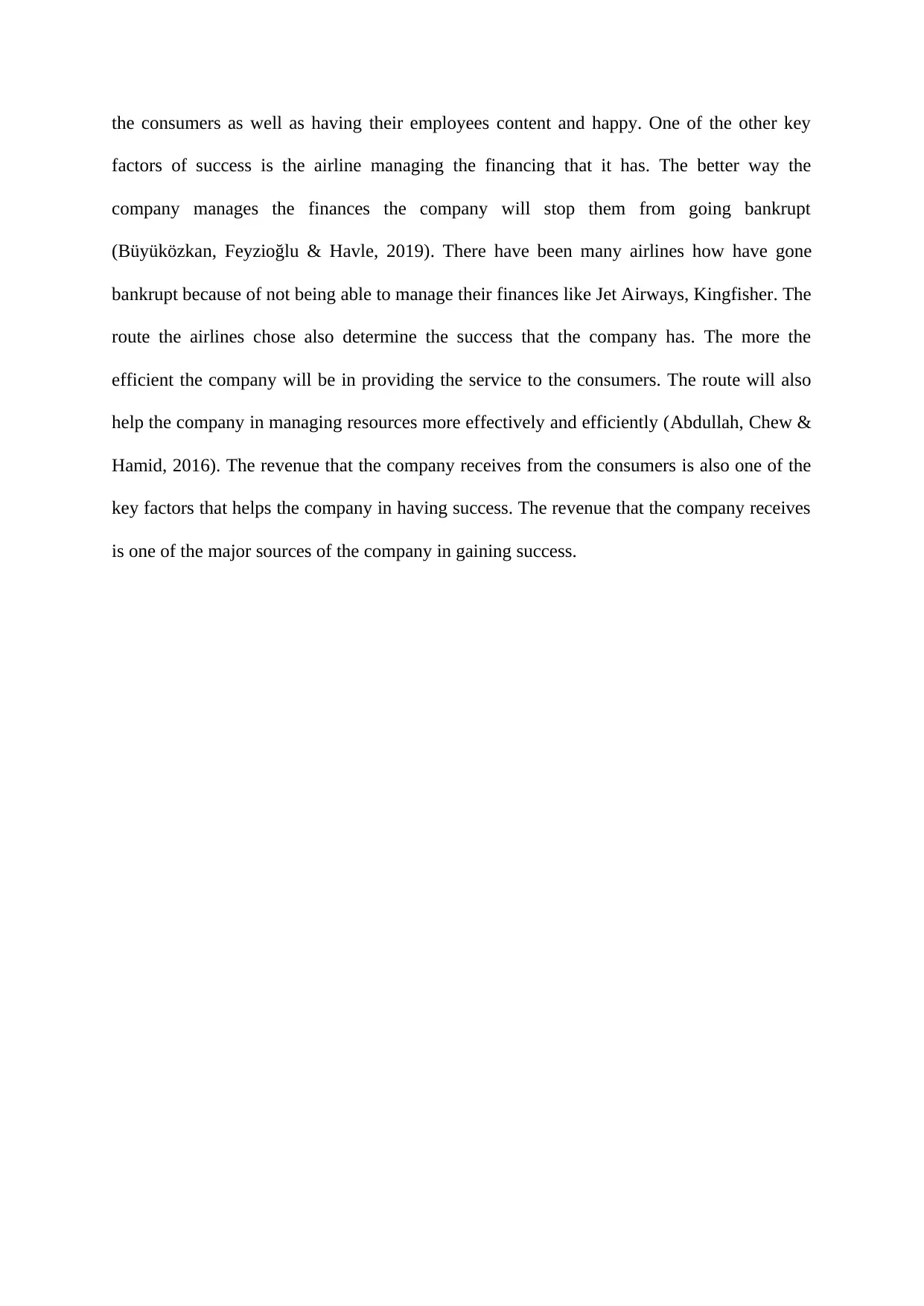
the consumers as well as having their employees content and happy. One of the other key
factors of success is the airline managing the financing that it has. The better way the
company manages the finances the company will stop them from going bankrupt
(Büyüközkan, Feyzioğlu & Havle, 2019). There have been many airlines how have gone
bankrupt because of not being able to manage their finances like Jet Airways, Kingfisher. The
route the airlines chose also determine the success that the company has. The more the
efficient the company will be in providing the service to the consumers. The route will also
help the company in managing resources more effectively and efficiently (Abdullah, Chew &
Hamid, 2016). The revenue that the company receives from the consumers is also one of the
key factors that helps the company in having success. The revenue that the company receives
is one of the major sources of the company in gaining success.
factors of success is the airline managing the financing that it has. The better way the
company manages the finances the company will stop them from going bankrupt
(Büyüközkan, Feyzioğlu & Havle, 2019). There have been many airlines how have gone
bankrupt because of not being able to manage their finances like Jet Airways, Kingfisher. The
route the airlines chose also determine the success that the company has. The more the
efficient the company will be in providing the service to the consumers. The route will also
help the company in managing resources more effectively and efficiently (Abdullah, Chew &
Hamid, 2016). The revenue that the company receives from the consumers is also one of the
key factors that helps the company in having success. The revenue that the company receives
is one of the major sources of the company in gaining success.
Paraphrase This Document
Need a fresh take? Get an instant paraphrase of this document with our AI Paraphraser
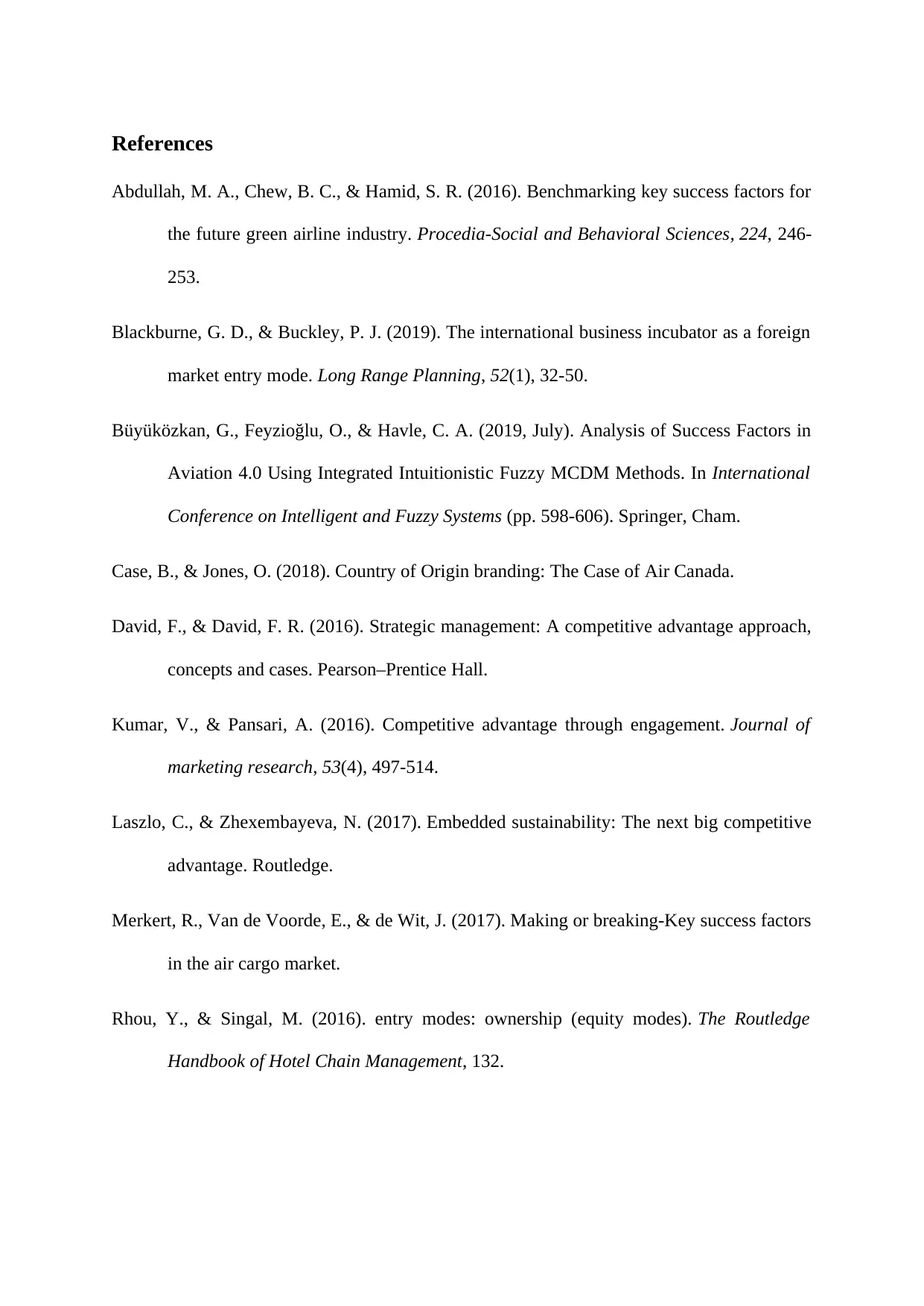
References
Abdullah, M. A., Chew, B. C., & Hamid, S. R. (2016). Benchmarking key success factors for
the future green airline industry. Procedia-Social and Behavioral Sciences, 224, 246-
253.
Blackburne, G. D., & Buckley, P. J. (2019). The international business incubator as a foreign
market entry mode. Long Range Planning, 52(1), 32-50.
Büyüközkan, G., Feyzioğlu, O., & Havle, C. A. (2019, July). Analysis of Success Factors in
Aviation 4.0 Using Integrated Intuitionistic Fuzzy MCDM Methods. In International
Conference on Intelligent and Fuzzy Systems (pp. 598-606). Springer, Cham.
Case, B., & Jones, O. (2018). Country of Origin branding: The Case of Air Canada.
David, F., & David, F. R. (2016). Strategic management: A competitive advantage approach,
concepts and cases. Pearson–Prentice Hall.
Kumar, V., & Pansari, A. (2016). Competitive advantage through engagement. Journal of
marketing research, 53(4), 497-514.
Laszlo, C., & Zhexembayeva, N. (2017). Embedded sustainability: The next big competitive
advantage. Routledge.
Merkert, R., Van de Voorde, E., & de Wit, J. (2017). Making or breaking-Key success factors
in the air cargo market.
Rhou, Y., & Singal, M. (2016). entry modes: ownership (equity modes). The Routledge
Handbook of Hotel Chain Management, 132.
Abdullah, M. A., Chew, B. C., & Hamid, S. R. (2016). Benchmarking key success factors for
the future green airline industry. Procedia-Social and Behavioral Sciences, 224, 246-
253.
Blackburne, G. D., & Buckley, P. J. (2019). The international business incubator as a foreign
market entry mode. Long Range Planning, 52(1), 32-50.
Büyüközkan, G., Feyzioğlu, O., & Havle, C. A. (2019, July). Analysis of Success Factors in
Aviation 4.0 Using Integrated Intuitionistic Fuzzy MCDM Methods. In International
Conference on Intelligent and Fuzzy Systems (pp. 598-606). Springer, Cham.
Case, B., & Jones, O. (2018). Country of Origin branding: The Case of Air Canada.
David, F., & David, F. R. (2016). Strategic management: A competitive advantage approach,
concepts and cases. Pearson–Prentice Hall.
Kumar, V., & Pansari, A. (2016). Competitive advantage through engagement. Journal of
marketing research, 53(4), 497-514.
Laszlo, C., & Zhexembayeva, N. (2017). Embedded sustainability: The next big competitive
advantage. Routledge.
Merkert, R., Van de Voorde, E., & de Wit, J. (2017). Making or breaking-Key success factors
in the air cargo market.
Rhou, Y., & Singal, M. (2016). entry modes: ownership (equity modes). The Routledge
Handbook of Hotel Chain Management, 132.
1 out of 8
Related Documents
Your All-in-One AI-Powered Toolkit for Academic Success.
+13062052269
info@desklib.com
Available 24*7 on WhatsApp / Email
![[object Object]](/_next/static/media/star-bottom.7253800d.svg)
Unlock your academic potential
© 2024 | Zucol Services PVT LTD | All rights reserved.





